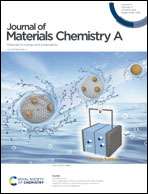A membrane-less desalination battery with ultrahigh energy efficiency†
Abstract
Seawater desalination is the most promising solution to a sustainable water future. However, state-of-the-art desalination technologies suffer from energy intensiveness and high capital expenditure. To address these issues, we have developed a novel, membrane-less desalination battery comprising negatively charged redox-active electrodes. A two-dimensional (2D) Ni and Co bimetallic metal–organic framework anchored on a black phosphorus nanosheet (NiCo MOF@BP) composite with fast sodium ion transport kinetics and favourable redox potentials for sodiation/desodiation when coupled with reduced graphene oxide supported silver nanoparticles (Ag@rGO) is applied. The incorporation of black phosphorus stabilizes the NiCo MOF and improves the overall electrical conductivity. Ultrastable cycling (46.5 mA h g−1 after over 1000 cycles in 2 M NaCl solution and 33.4 mA h g−1 after over 500 cycles in synthetic seawater at 0.3 A g−1) and rate performance (25.7 mA h g−1 at 2.5 A g−1) are realised. Besides, a high coulombic efficiency of 96.9% and superb energy recovery of 70.7% are achieved. As such, a low energy consumption of 0.034 W h g−1 with a salt removal capacity of 103.1 mg g−1 is obtained using synthetic seawater as the electrolyte, which is among the lowest in energy consumption when compared with other similar desalination technologies. The exploration of this novel cathode material paves the way for future material selection for desalination batteries.



 Please wait while we load your content...
Please wait while we load your content...